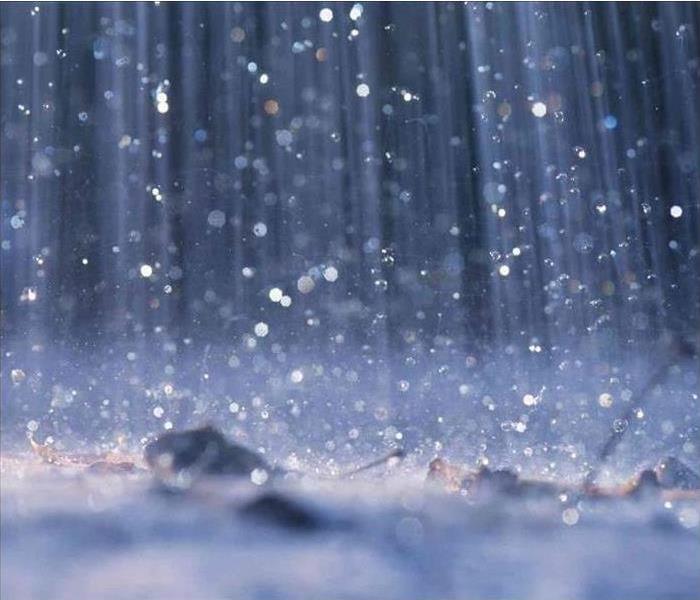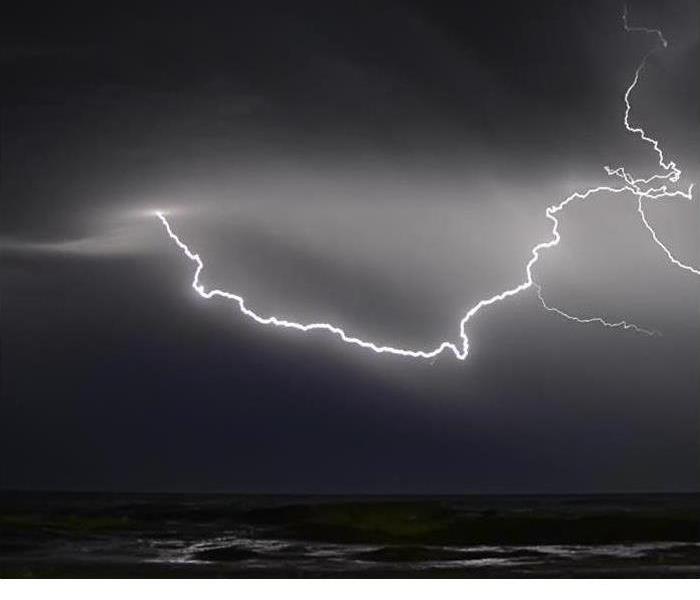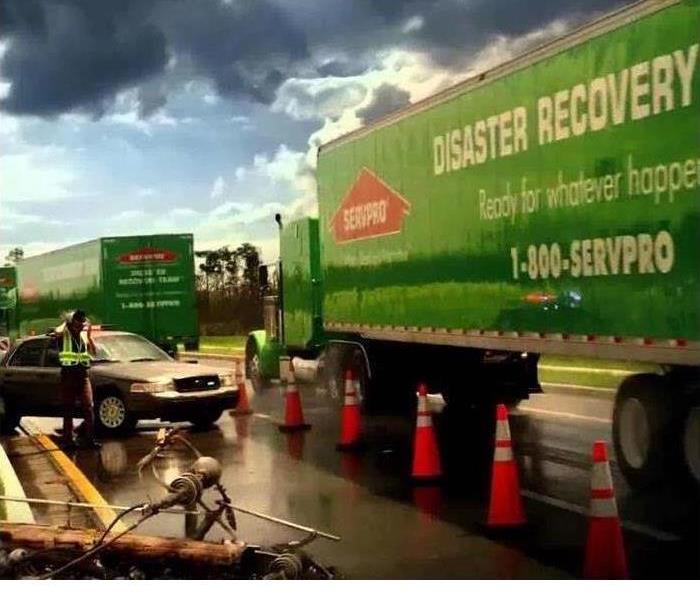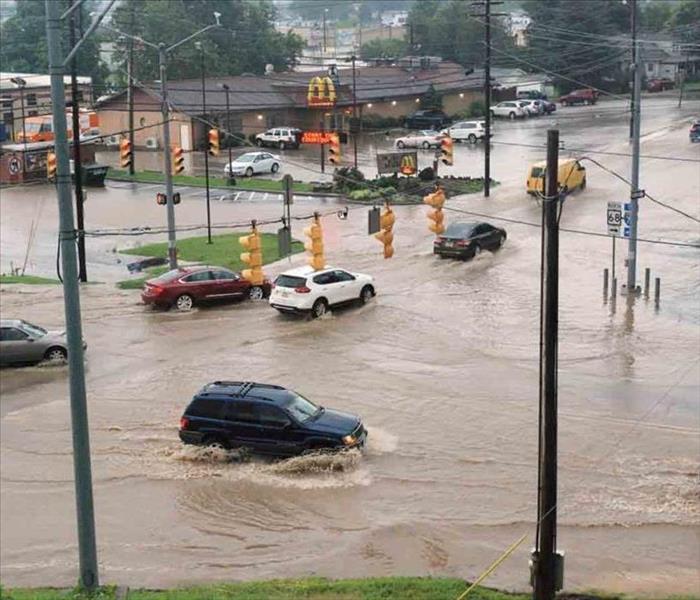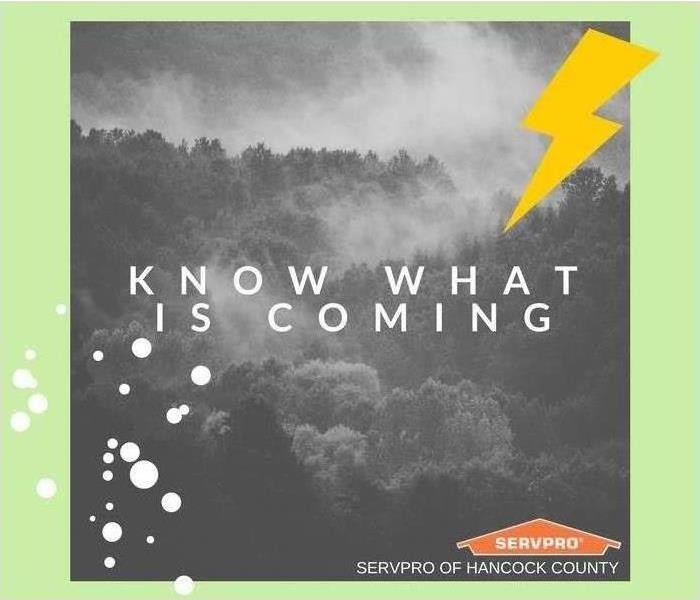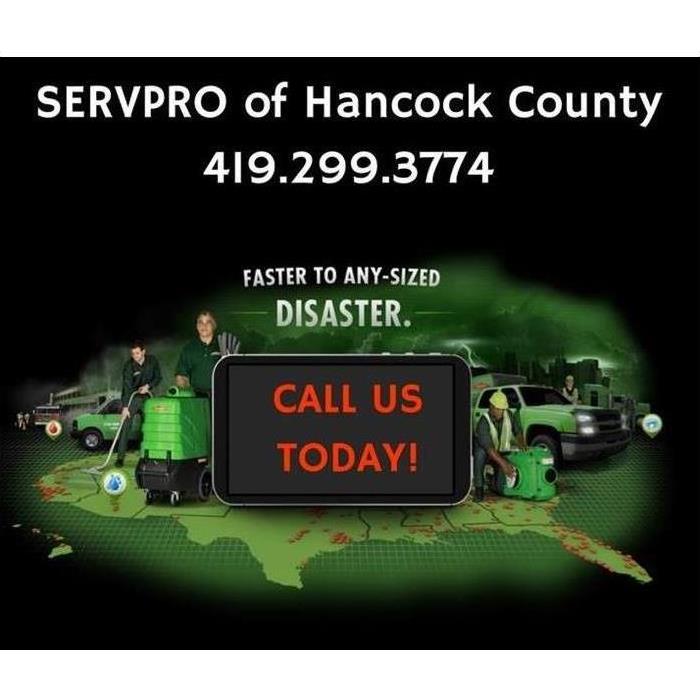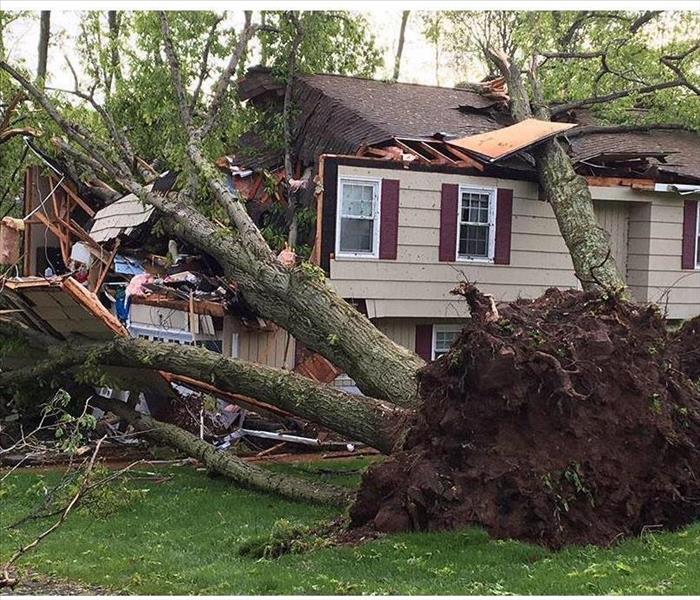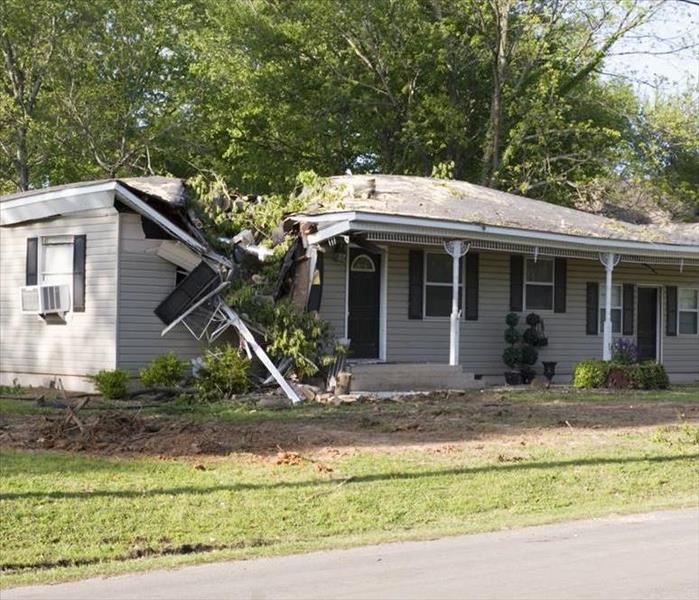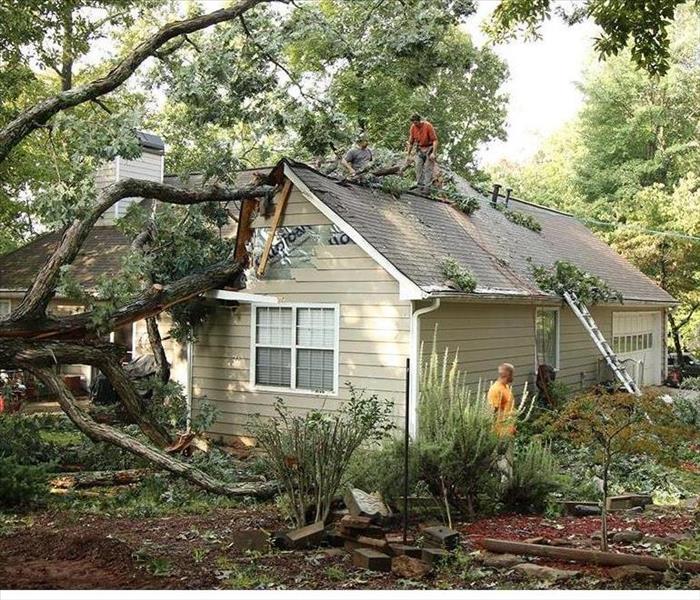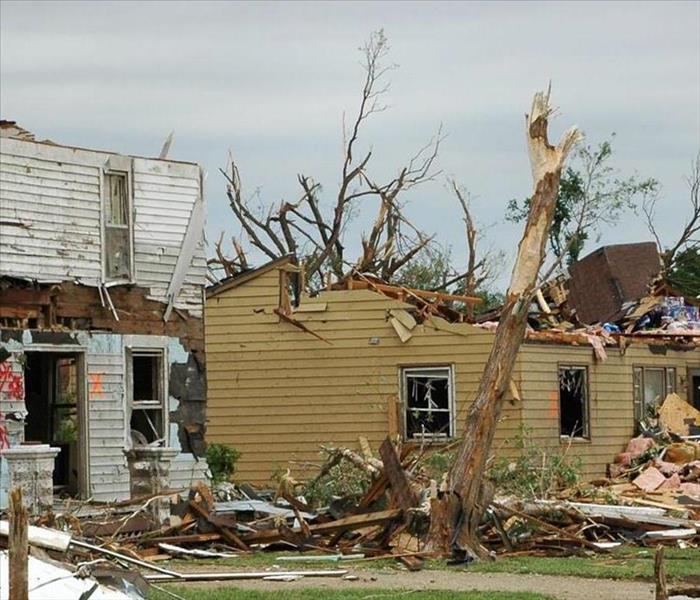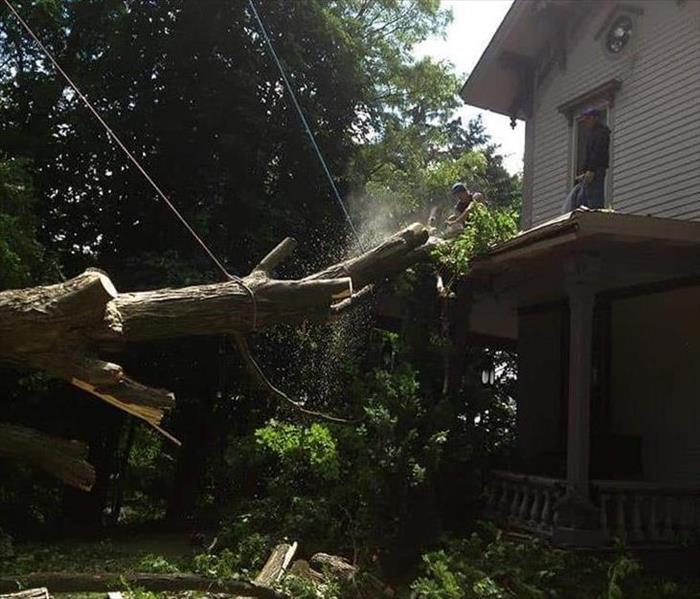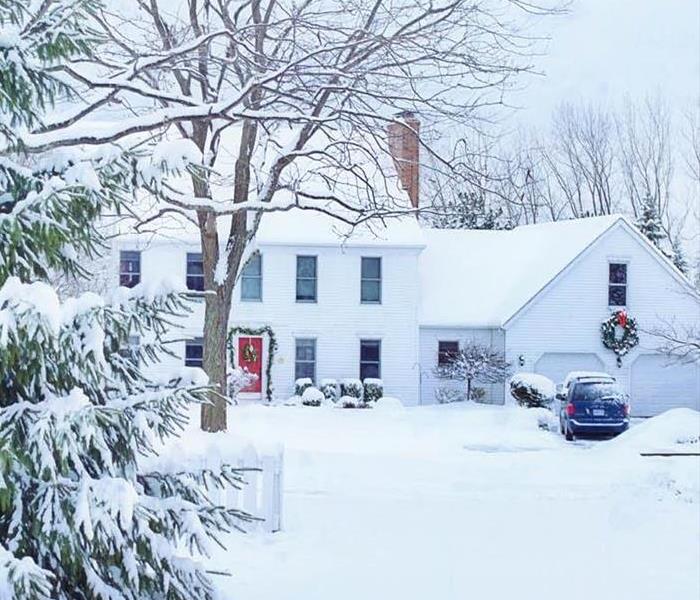Recent Storm Damage Posts
Summer Rain
5/26/2022 (Permalink)
Summer typically brings a good amount of rainfall. As much as we all love the warmer weather, heavy rain can cause stress for many families. Those who are located in flood zones, have cracks in their foundations, or simply have a bad sump pump, will all, unfortunately, experience some sort of water damage. Water damage may occur occasionally for some, while others may have water damages each time that it rains. Having flood insurance and/or fixing cracks in your homes foundation can help to alleviate the stresses that come with water damages.
Why does my basement flood when it rains?
When the ground absorbs the water, the water needs somewhere to expel. The ground will eventually become saturated and need to get rid of the water that it has absorbed. Where does the water go? The rain drains into cracks in your homes foundation and creates havoc for your basement. In the event that your basement has standing water, it’s also important to understand the possible hazards.
If there are any electrical wires, outlets, cords, or the like, in the area, then it’s important that you do not enter the standing water. SERVPRO® of Hancock County is committed to keeping your family safe and getting your home back to normal as fast and efficiently as possible.
We're available 24/7 should you find yourself needing our water mitigation expertise. We can be reached by calling 419-299-3774.
Understanding the Storm
5/25/2022 (Permalink)
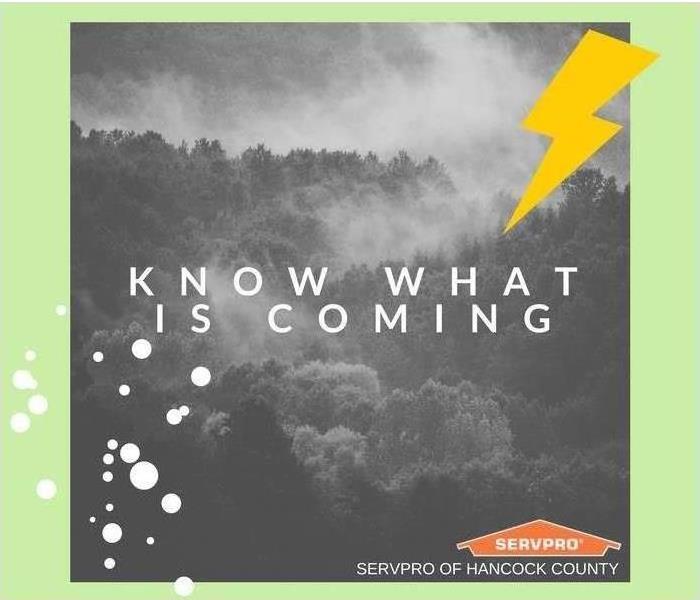 Storm damage? Call us!
Storm damage? Call us!
In our region, we see a variety of seasons throughout the year. Snow, rain, and wind all cause various problems for areas of our community, and we want to make sure that the different types of storms are understood.
Blizzards
Snow seems to come and go throughout the Winter months lately, but it never hurts to thoroughly understand what can happen. A blizzard is classified as a storm with blowing snow and winds of 40mph or higher, over a span of at least four hours. Blizzards can cause frigid temperatures, which can sometimes be dangerous to breath in, along with poor visibility when driving.
Thunderstorms
Heavy rainfall and high winds, along with lightning and thunder, can be considered a thunderstorm. However, there are severe thunderstorms as well. A thunderstorm is “severe” when there is hail that is one or more inches in diameter and winds that exceed 57.5mph. The high winds and heavy rainfall can create flooding and even the removal of siding, porch objects, and shingles.
If high winds are removing the siding and shingles from your home, while it’s raining excessively, it can cause flooding and/or any form of water damage. Rain can creep its way inside through tiny cracks in walls, spouting, and windows. This is why it’s important to weather proof your home when you’re sure there is a severe thunderstorm coming.
Ice Storms
Ice storms include freezing rain, which sticks and freezes everything that it comes into contact with. This leaves roads more slippery than if there were only snow on them, which creates a greater danger to our community. Cold temperatures can cause pipes in your home to freeze and burst, leaving you with water damage. No worries though, SERVPRO® of Hancock County can help you immediately, as we provide 24/7 Emergency Service to the Hancock County area.
You can reach us by calling 419-299-3774 or through our website at https://www.SERVPROhancockcounty.com/contact/contactus
Storm & Weather
10/21/2021 (Permalink)
Storms can be harmless, but they can also be potentially disastrous. High winds, lighting strikes, and a large amount of rain can cause an abundance of problems for our community members, both commercial and residential. Lightings can spark fires, rain can cause flooding and backups, and high winds can cause electricity to go out.
If you find yourself in the midst of a flood or fire, the most important thing you can do is ensure that you and those around you are safe. You may need to relocate yourselves and leave items behind. If that is the case, SERVPRO® of Hancock County is able to use advanced technology and techniques to virtually restore your items to their previous conditions.
SERVPRO® of Hancock County has experienced professionals who are highly trained. Our team will provide you with quick and accurate service, whether you have water damage or a fire cleanup.
You can reach us 24/7 by calling us at 419-299-3774, by reaching out to us through our website at:
https://www.SERVPROhancockcounty.com/contact/contactus
Remember we're here to help 24/7 to make it "Like it never even happened."®
When Storms and Flooding Hit, We Are Here To Help!
10/21/2021 (Permalink)
SERVPRO® of Hancock County specializes in storm and flood damage restoration. Our crews are highly trained and we use specialized equipment to restore your property to its pre-storm condition.
We know flooding and storms create havoc when damage occurs to your home or business. Our team is dedicated to assisting you in restoring your home. SERVPRO® of Hancock County works directly with your insurance company to ease the burden for our clients. We're available 24/7 by calling 419-299-3774 or by reaching us through our FaceBook page at https://www.facebook.com/SERVPROhancock/.
Remember you do not have to go through a flood or storm alone! Our team is ready to help you, day or night, 24/7!
Storms & Flooding
10/21/2021 (Permalink)
Floods can strike anywhere and at any time. It’s important to know whether or not your home is located in a flood zone. If it is, then you should begin preparations immediately, and always have a plan of action.
BEFORE THE FLOOD
You can install “check valves” into your sewer traps to prevent the flood from backing up your sewage and sump pump. Basement walls are prone to cracking and moisture build up. This can be resolved by waterproofing your basement by sealing the walls. This step will always help to prevent microbial growth.
DURING THE FLOOD
Electrical currents can run through water, making standing water dangerous in some cases. If it’s safe to do so, shut off the electricity to any areas affected by flood water. Since standing flood water may contain contaminated contents, try to avoid walking through the water.
AFTER THE FLOOD
In many cases, floods can cause the public water supply to become dangerous to consume. Keep an eye out for water alerts from your local news service. If you have flood insurance, it’s important to understand what is covered and what is not.
SERVPRO® OF HANCOCK COUNTY & STORM DAMAGE
SERVPRO® of Hancock County can respond immediately to your location. Our technicians are professionally trained through the IICRC to perform water removal and extraction to the affected areas of your home. We treat our community members and customers like family, so that you can rest easy knowing the job will be done by people who care.
Call us directly at 419-299-3774 for help.
Understanding The Storm
10/6/2021 (Permalink)
In our region, we see a variety of seasons throughout the year. Snow, rain, and wind all cause various problems for areas of our community, and we want to make sure that the different types of storms are understood.
Blizzards
Snow seems to come and go throughout the Winter months lately, but it never hurts to thoroughly understand what can happen. A blizzard is classified as a storm with blowing snow and winds of 40mph or higher, over a span of at least four hours. Blizzards can cause frigid temperatures, which can sometimes be dangerous to breath in, along with poor visibility when driving.
Thunderstorms
Heavy rainfall and high winds, along with lightning and thunder, can be considered a thunderstorm. However, there are severe thunderstorms as well. A thunderstorm is “severe” when there is hail that is one or more inches in diameter and winds that exceed 57.5mph. The high winds and heavy rainfall can create flooding and even the removal of siding, porch objects, and shingles.
If high winds are removing the siding and shingles from your home, while it’s raining excessively, it can cause flooding and/or any form of water damage. Rain can creep its way inside through tiny cracks in walls, spouting, and windows. This is why it’s important to weather proof your home when you’re sure there is a severe thunderstorm coming.
Ice Storms
Ice storms include freezing rain, which sticks and freezes everything that it comes into contact with. This leaves roads more slippery than if there were only snow on them, which creates a greater danger to our community. Cold temperatures can cause pipes in your home to freeze and burst, leaving you with water damage. No worries though, SERVPRO® of Hancock County can help you immediately, as we provide 24/7 Emergency Service to the Hancock County area.
You can reach us by calling 419-299-3774 or through our website at https://www.SERVPROhancockcounty.com/contact/contactus
Storm Team Ready!
9/14/2021 (Permalink)
Storms typically bring wind and rain showers, and both can cause damage to communities in it’s pathway. Severe storms occur when hail, high wind, and tornadoes are present within the storm. High winds can remove siding from your home, tear shingles off of your roof, and even blow foreign debris in the air. If you’re local weather service announces that a severe storm watch or warning are in effect, you should take precautions to protect yourself.
- Supply your home with an emergency supply kit.
- Recommended items include a first aid kit, food (non-perishable), water, battery operated flashlights, hygiene items and sometimes cash.
- Create a family emergency exit plan.
- Stay inside.
- Secure any outdoors objects such as patio furniture, décor, etc. to prevent them from blowing away or being damaged.
When a storm presents itself unexpectedly, actions need to be taken immediately. Local emergency services will be on standby, as well as your local SERVPRO® of Hancock County. As soon as you realize you have water, storm, or fire damage, call us immediately. We can be on site as soon as possible with skilled professionals and advanced equipment.
Call us at 419-299-3774 to assist with any of your mitigation needs from storms or flooding.
How to protect your home and family during a storm.
2/10/2020 (Permalink)
Year-to-year, the severity and frequency of bad weather is anyone’s guess. But, inevitably, a lot of homeowners end up dealing with property damage as a result of storms. Some things you can do to keep your home and family safe from these storms are...
1. REPLACE MISSING OR DAMAGED SHINGLES
If a shingle is damaged, it’s more likely to break free. If it’s missing, well then you’ve got a gap for wind to get under and do even more damage.
Note that when you’re installing or replacing shingles, they must be nailed properly — NOT above the nail line.
2. REPAIR LOOSE SIDING
The same rules as roofing apply to siding: it’s important to ensure your siding isn’t damaged.
3. KEEP YOUR GUTTERS CLEAR
Make sure your gutters are free-flowing and your downspouts flow away from your foundation.
Water damage or flooding is one of the quickest ways to devalue your home. So ensuring your gutters are clear is the first line of defense in helping water to flow away from your home. Which leads to another important preventative measure …
4. ENSURE WATER CAN FLOW AWAY FROM YOUR HOME
The grade of your lot should keep water flowing away from your home and into a ditch, drain, or some other proper retention area.
5. KEEP YOUR SUMP PUMP IN WORKING ORDER
Before Spring rains start up, we suggest checking whether your sump pump is in working order. If you want to feel extra-secure, having a backup sump pump is a sure-fire way to prevent basement flooding.
6. ENSURE PROPER SEALING OF DOORS AND WINDOWS
Wind only needs a small opening to get underneath something like a shingle or siding and rip it off. And in the event of tornadic winds, a small opening in your windows or doors could enlarge (read: break) and allow enough wind inside to compromise your home’s roof.
7. CHECK FOR LOOSE FENCE POSTS
Wind will surprise you. Anything that’s not nailed down is a liability, and that includes fence posts, which are often forgotten or ignored in homeowner’s storm-prep.
Checking your fence’s footing is as easy as giving each post a strong shake to check for loose ones.
8. REGULARLY TRIM YOUR TREES
Problem tree limbs can damage your home, a vehicle, or even your neighbor’s property. Regularly trimming the trees on your property is an excellent way to protect your roof and windows.
9. WALK AROUND YOUR PROPERTY
A lot of people don’t have the time or skills to check and/or repair everything on their property before storm season kicks up. But, if you know a storm is coming, there are some very basic steps you can take to minimize its impact.
10. KEEP A GENERATOR ON HAND
A bad storm could potentially knock out power to your home for a couple of hours — or days. Having a generator on standby could go a long way towards ensuring you don’t lose your food, or the livability of your home until power is restored.
What can really happen to your home after a storm
1/31/2020 (Permalink)
Lightning storms can occur anywhere in the U.S., and they bring the threat of fires and severe structural damage. Even if your lightning rods work properly by channeling the energy to the ground, it’s possible to see damage to electrical wiring, appliances, antennas, satellite dishes, cable or telephone lines, and steel framework. Unless there are signs of fire, be sure to stay indoors until the storm is over because your home will protect you.
Thunderstorms come with risks even if you aren’t hit by lightning. You could see dangerous flash flooding, hail and high winds.
Flooding presents a serious risk to your home and your safety. According to the U.S. National Severe Storms Laboratory, floods kills more people every year than lightning, hurricanes and tornadoes combined.
When it comes to structures, flooding can lead to dangerous contamination and damage to drywall, support beams and foundations. You are at risk for mold within the first 24 hours of a flood, so it’s vital to stop the water from flowing and start remediation quickly.
Different types of floods come with different risks. River floods and flash floods are common when snow melts and have been known to completely overwhelm structures. Coastal floods and storm surges are even more dangerous, and usually lead to evacuation warnings. These can destroy homes entirely, so it’s best to listen to weather reports and plan ahead. Debris flows, which are often made up of heavy mud and plant material, can crush houses and sweep them away.
Damage from wind can be widespread and can affect not only your structure but also surrounding landscaping and asphalt. Be aware of the potential for falling trees and poles and damaged power lines, and take care of these problems right away. After the storm, examine your property for structural damage to the home, including windows, siding and roofs. In the most extreme scenarios, roofs can be blown clean off.
How to stay safe after a storm has damaged your home
1/24/2020 (Permalink)
Dealing with wind or water damage to your home caused by hurricanes, tornadoes, or other severe storms can be both difficult and dangerous. Here are some tips on how keep your family safe and begin to get your life back together after a storm hits.
Staying Safe After a Storm
- Listen to the radio for advisories and other instructions.
- Do not venture outside until it has been declared safe to do so.
- Stay away from downed power lines and avoid standing water or metal objects near downed wires.
- Leave and do not enter buildings that have sustained structural damage.
- Stay away from damaged trees and dangling or broken limbs.
- Do not swim or wade in flood waters.
- Check on neighbors, especially those who are elderly or disabled.
- Watch out for snakes or other wild animals.
- Turn the gas off at the meter if you smell gas.
- Do not drive unless absolutely necessary.
- If you must drive, watch for undermined roads and damaged bridges.
- Do not attempt to drive through flooded streets or bridges.
- Avoid using candles or other open flames indoors.
- Keep a fire extinguisher handy at all times.
- Test battery powered smoke and CO alarms.
- Make sure your sewer system is working before flushing toilets.
- Keep pets indoors and use a leash when taking them outside.
- Operate generators outdoors in the open away from windows and doors.
- Don’t eat perishable food that has warmed to over 40° F.
How to prepare for tornado season.
1/22/2020 (Permalink)
To protect your property, your family, and yourself during a tornado, it’s useful to develop a plan before the tornado hits. Make sure everyone is familiar with this plan.
As part of the plan, gather contact information and important documents in one place.
Contact information: You should record contact information for:
- Family members – personal cell phones
- Workplaces
- Schools
- Babysitters
- Utility companies
- Any other relevant contact details (such as family friends)
By recording all of these, you can contact friends, family members, and other important people at any time.
Important documents: Your plan should contain copies of:
- Birth certificates
- Social security cards
- Insurance policies
- Photos of your property, for insurance purposes
These documents will be vital if you need to evacuate the area or file an insurance claim following a tornado.
You should also create multiple evacuation plans, in case you need to leave the area and one route is not accessible.
Step 2: Build an emergency kit
The second step to preparing for a tornado is to make an emergency kit. Emergency kits are helpful in the event you lose power or other utilities, get injured, or become trapped. An emergency kit should include:
- Enough water and food for at least three days per person
- A device for communication (such as a radio)
- First aid supplies
- Spare clothes
- Flashlights
- Batteries
- Toiletries
- Maps of the local area
- Medications
How many supplies you need depends on the size of your family. Be sure to pay extra attention to any special circumstances within your family; any infants, medical conditions, or pets will require extra resources. Take all this into account when preparing your emergency kit.
Step 3: Identify shelter areas, or build a safe room
Another way to prepare for a tornado and stay safe when a tornado hits is to identify or build a safe place in your home to take shelter. Your shelter area or safe room should:
- Be on the lowest floor
- Have no windows
- Be as close to the center of the building as possible
- Contain your emergency kit
For these reasons, basements tend to make good shelter areas. If you don’t have a basement, a centrally located bathroom or closet also works.
When the tornado hits, you might not be at home, so identify other safe buildings and tornado shelters in the area, too, such as offices, schools, or town halls.
Common storm damage
1/21/2020 (Permalink)
Severe storms can be frightening and dangerous, and safety has to be your first priority. If your area has seen major problems, be careful. If you think your home has been structurally damaged or if flood risk remains, don’t go inside until a professional says it’s safe. Spending a few nights at a friend’s house or in an emergency shelter is a small price to pay.
Once the disaster has passed, it’s important to assess the damage and get started with cleanup and restoration. Below, we’ve provided information about the damage different kinds of storms can cause and how you can protect your property value in different scenarios.
Water Damage
Water damage is a very common problem following a major storm. Heavy rains and winds can cause any minor opening in your home to become a gateway for water to seep in and cause damage. When recognized, it is important to have a water damage remediation specialist assess the issue and do what they can to fix it as quickly as possible to maintain the structural integrity of your home.
Fire and Smoke Damage
Lightning strikes or electrical fires can occur during storms. Fire and smoke damage can seem almost impossible to repair, but the specialists at SERVPRO can clean it up and make it "Like it never even happened."
Any time you have any type of damage to your home or business because of a storm call SERVPRO of Hancock County at 419-299-3774.
How to prepare your home for a winter storm!
1/20/2020 (Permalink)
It is that time of year again! It is always good to know what you need to do to prepare your home for a winter storm.
There are many things you can do to prepare for a winter storm. Some key things to make sure your home is safe for a winter storm are: making sure the attic, basement, and walls are insulated properly so that your home stays warm and warms up more efficiently, also heating systems should be cleaned and serviced properly each year before use to make sure they are safe and working properly. Any drafty areas should be caulked or repaired and the roof should be checked to ensure no leaks are coming from it and make sure it can bear the weight of the snow.
If your home happens to get damaged in a winter storm call SERVPRO of Hancock County at 419-299-3774 so we can help you get it taken care of properly!
Spring Showers
3/1/2019 (Permalink)
 Spring Showers
Spring Showers
Spring typically brings a good amount of rainfall. As much as we all love the warmer weather, heavy rain can cause stress for many families. Those who are located in flood zones, have cracks in their foundations, or simply have a bad sump pump, will all, unfortunately, experience some sort of water damage. Water damage may occur occasionally for some, while others may have water damages each time that it rains. Having flood insurance and/or fixing cracks in your homes foundation can help to alleviate the stresses that come with water damages.
Why does my basement flood when it rains?
When the ground absorbs the water, the water needs somewhere to expel. The ground will eventually become saturated and need to rid of the water that it has absorbed. Where does the water go? The rain drains into cracks in your homes foundation and creates havoc for your basement. In the event that your basement has standing water, it’s also important to understand the possible hazards.
If there are any electrical wires, outlets, cords, or the like, in the area, then it’s important that you do not enter the standing water. SERVPRO® of Hancock County is committed to keeping your family safe and getting your home back to normal as fast and efficiently as possible.
We're available 24/7 should you find yourself needing our water mitigation expertise. We can be reached by calling 419-299-3774 or by emailing our Production Manager, Chase Perkins at cperkins@SERVPROhancockcounty.com
Polar Vortex
2/5/2019 (Permalink)
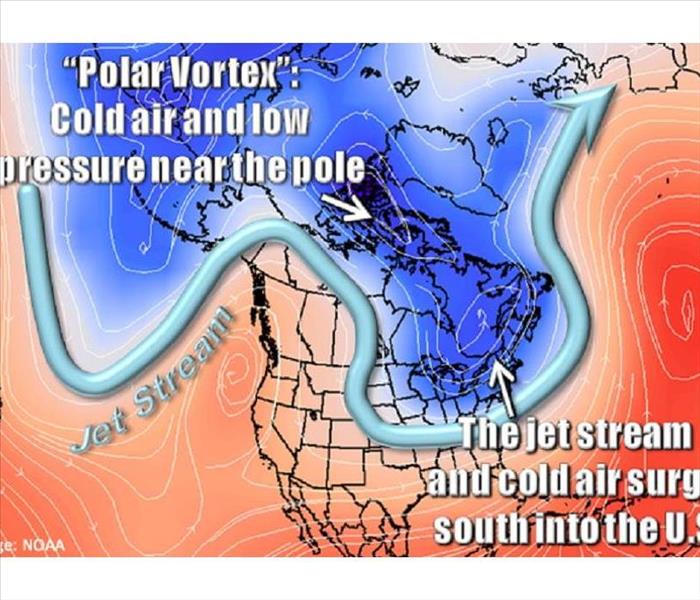 Polar Vortex
Polar Vortex
The end of January weather created a lot of problems for the Midwest region. Schools closed for multiple days, while the children I'm sure enjoyed 3 days off from school, the cold temperatures brought more concern to home owners and parents.
Freezing temperatures and howling wind with the negative wind chill created havoc for the Midwest and frozen and broken pipes.
So what is a Polar Vortex? From weather.gov website we learned:
https://www.weather.gov/safety/cold-polar-vortex
"The polar vortex is a large area of low pressure and cold air surrounding both of the Earth’s poles. It ALWAYS exists near the poles, but weakens in summer and strengthens in winter. The term "vortex" refers to the counter-clockwise flow of air that helps keep the colder air near the Poles. Many times during winter in the northern hemisphere, the polar vortex will expand, sending cold air southward with the jet stream (see graphic above). This occurs fairly regularly during wintertime and is often associated with large outbreaks of Arctic air in the United States. The one that occurred January 2014 is similar to many other cold outbreaks that have occurred in the past, including several notable colder outbreaks in 1977, 1982, 1985 and 1989.
There are several things the polar vortex is NOT. Polar vortexes are not something new. The term “polar vortex” has only recently been popularized, bringing attention to a weather feature that has always been present. It is also not a feature that exists at the Earth’s surface. Weather forecasters examine the polar vortex by looking at conditions tens of thousands of feet up in the atmosphere; however, when we feel extremely cold air from the Arctic regions at Earth’s surface, it is sometimes associated with the polar vortex. This is not confined to the United States. Portions of Europe and Asia also experience cold surges connected to the polar vortex. By itself, the only danger to humans is the magnitude of how cold temperatures will get when the polar vortex expands, sending Arctic air southward into areas that are not typically that cold.
In short, there is no cause to be alarmed when you hear about the polar vortex, but you should be prepared for colder temperatures. Check the forecast for your area on weather.gov to ensure you are dressed appropriately. It is also a good idea to check the items in your home and car emergency kits at the beginning of each winter season to ensure you are prepared for any type of hazardous winter weather."
If you find yourself with water damage due to the Polar Vortex, remember your SERVPRO® of Hancock County employees are here to help! We can be reached at 419-299-3774 - 24/7.
Storm Team Ready
1/10/2019 (Permalink)
Storms typically bring wind and rain showers, and both can cause damage to communities in it’s pathway. Severe storms occur when hail, high wind, and tornadoes are present within the storm. High winds can remove siding from your home, tear shingles off of your roof, and even blow foreign debris in the air. If you’re local weather service announces that a severe storm watch or warning are in effect, you should take precautions to protect yourself.
- Supply your home with an emergency supply kit.
- Recommended items include a first aid kit, food (non-perishable), water, battery operated flashlights, hygiene items and sometimes cash.
- Create a family emergency exit plan.
- Stay inside.
- Secure any outdoors objects such as patio furniture, décor, etc. to prevent them from blowing away or being damaged.
When a storm presents itself unexpectedly, actions need to be taken immediately. Local emergency services will be on standby, as well as your local SERVPRO® of Hancock County. As soon as you realize you have water, storm, or fire damage, call us immediately. We can be on site as soon as possible with skilled professionals and advanced equipment.
Call us at 419-299-3774 to assist with any of your mitigation needs from storms or flooding.






 24/7 Emergency Service
24/7 Emergency Service
